Introduction
Laboratory dyeing plays a pivotal role in ensuring the color accuracy of dyed polyester fabrics in textile factories. Proper sampling methods, accurate equipment usage, and precise dye preparation are essential for achieving consistent results in bulk production. This guide explores the importance of laboratory dyeing in textile dyeing processes, focusing on polyester fabric dyeing with disperse dyes. Key aspects covered include laboratory dyeing equipment, fabric preparation, dye solution handling, and maintenance practices for enhanced color accuracy.
The Importance of Laboratory Sampling in Dyeing and Printing Factories
In daily production, factors impacting the color accuracy of polyester fabric finished products include the precision of dyeing lab sampling. Enhancing the accuracy of laboratory sampling is critical for improving textile dyeing results. This article elaborates on textile dyeing processes using sample dyeing machines and dyeing lab machines as examples.

Laboratory Dyeing Equipment
Key lab dyeing equipment includes:
High-Temperature High-Pressure Lab Dyeing Machine
Glycerin Lab Dyeing Machine
Infrared Lab Dyeing Machine (IR Lab Dyeing Machine)
High-Temperature High-Pressure Lab Dyeing Machine: Features and Key Usage Points
Features
This textile dyeing equipment can reach a maximum temperature of 130°C, making it ideal for polyester sampling. Proper usage involves ensuring the correct bath ratio for accurate textile dyeing processes. It is powered by two electric heating tubes. It can hold up to 12 dyeing cups, and the sampling process is achieved by a connecting rod device that moves the hook with the sample up and down. The maximum capacity of the dyeing cup is 300 ml, and the fabric weight determines the bath ratio.
The amount of dye solution added during sampling is based on the dyeing formula, and finally, water is added to two-thirds of the cup’s height, approximately 200 ml. If the liquid level is too high, the bath ratio will deviate significantly from that in actual production, affecting color accuracy. If it’s too low, the sample may not be fully immersed when the hook rises, resulting in sample streaking.
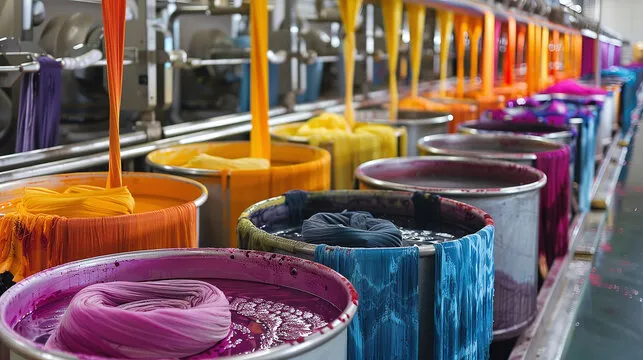
Key Usage Points
There are two common types of dyeing cups: glass and stainless steel. Before using a new cup, check its diameter. A larger diameter can cause the cup to get stuck after dyeing. When removing a glass dyeing cup, excessive force can lead to breakage, which not only injures the sampler’s hand but also risks cutting the sealing ring between the sampler’s hemispherical cover and the platform with small glass pieces, affecting the next sampling.
The glass cup is convenient for observing the dye solution residue, which is useful for inspecting new batches of dyes. For stainless steel cups, the residue must be poured into a beaker for inspection. Although stainless steel cups are less likely to break, a poor surface finish can reduce the cleaning efficiency. In addition to weekly cleaning of the small sampler, when a glass cup breaks, all the broken glass at the bottom must be cleaned up to prevent hand injuries during regular cleaning. When cleaning, drain all the water and check and clean the electric heating tube surface. Long-term accumulation of scale on the tube surface not only affects heating efficiency but also increases the risk of the tube bursting. If any bulging or significant deformation is detected during cleaning, replace the tube promptly to maintain the heating rate.
After each sample is hung on the hook, it must be properly fixed to avoid streaking if the hook comes off. However, over-tightening can cause the glass cup to break. If there are too many unsmooth wrinkles on the sample, light-colored samples may develop streaks or color deviations due to insufficient sampling insulation time.
Glycerin Lab Dyeing Machine: Features and Key Usage Points
Features
The glycerin dyeing lab machine generates high temperatures under normal pressure, with a higher capacity than high-temperature samplers. Proper fabric dyeing methods and dyeing lab practices are essential for maintaining accuracy. Its heating principle is the same as that of the high-temperature and high-pressure sampler. There are 12-cup and 24-cup versions available. The glycerol sampler’s dyeing cup has a larger capacity than the high-temperature and high-pressure sampler. The liquid level adjustment directly affects the bath ratio of the sample. It also has a higher degree of automation.
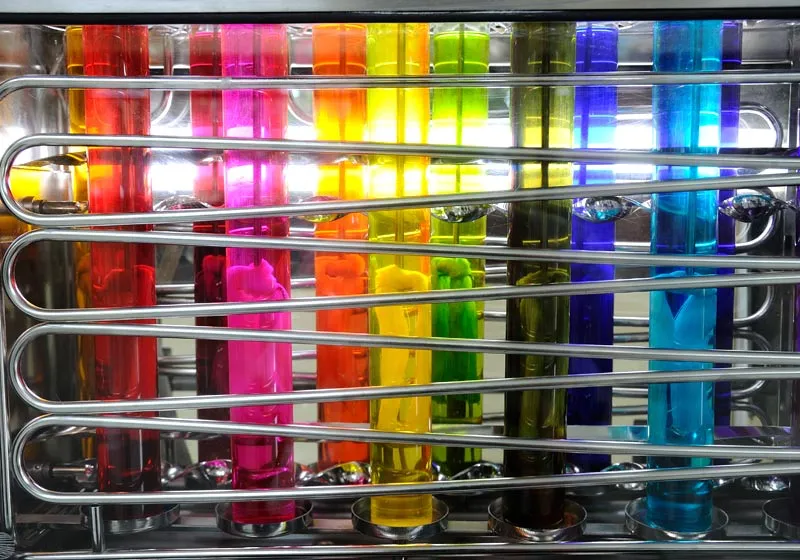
Key Usage Points
Suppose the liquid level in the dyeing cup is too high. In that case, the bath ratio of the dye solution will be too large, leading to a significant difference from the actual production bath ratio and affecting color accuracy. Conversely, if the bath ratio during sampling matches that in actual production, the cup’s bath ratio will be too small, and the liquid level will drop. In the case of the wheel-like rotating dyeing cup, the dye solution may not fully immerse the sample during operation, affecting the sample’s even dyeing and sampling efficiency.
The glycerol’s volatilization occurs with the evaporation of water in the glycerol heating pool, which mainly comes from the dyeing cup during sampling. The lid and cup body of the dyeing cup are paired. Incorrect lid placement or insufficient force when covering can cause leakage. After covering, invert the cup briefly to check for leaks. Leakage not only affects the sample’s color accuracy but also leads to excessive glycerol volatilization, filling the laboratory with a strong glycerol smell and causing discomfort to some samplers.
When placing the dyeing cup in the holder, ensure it is firmly seated. A loose fit can cause a cup jamming accident, severely damaging the small sampler and potentially burning out the motor or damaging the gearbox. The maintenance of the glycerol sampler’s heating device is similar to that of the high-temperature and high-pressure sampler’s electric heating tube.
After sampling, place the dyeing cup in a self-made glycerol recovery device for a while to allow the glycerol droplets on the cup surface to drip into the receiver. This is an effective way to save glycerol. As glycerol volatilizes, the internal interface height decreases. Regularly check and replenish the glycerol to maintain the sampler’s heating efficiency and improve sampling speed. The cooling devices of both the high-temperature and high-pressure and glycerol samplers should be connected with hoses for easy equipment movement and maintenance. If necessary, raise the bottom of the glycerol sampler to facilitate glycerol drainage.
Infrared Lab Dyeing Machine: Features and Key Usage Points
The IR lab dyeing machine offers high automation and consistent heating control. It is widely used for lab dyeing due to its efficiency and precision in fabric dyeing methods.
Infrared laboratory samply dyeing equipment come in 12-cup, 24-cup, and 36-cup models and generally have a higher degree of automation than glycerol samplers. They can be pre-programmed with several settings for different dye types. Program editing considers factors such as heating rate, maximum temperature, and holding time. Special dyeing processes can be programmed temporarily. Mature processes can be numbered, matching the numbering in the production workshop’s computer master control room.
Daily checks of the liquid level in the infrared sampler’s temperature control reference cup are necessary. A low liquid level can cause instantaneous temperature fluctuations. Filling the reference cup with water can eliminate this issue. Prolonged temperature fluctuations in the detection cup can lead to temperature measurement system failure and ultimately affect the sampler’s lifespan.
InfraDye Infrared Lab Dyeing Machine
The InfraDye lab dyeing machine is designed for cost-effective and rapid sample production. It operates on the infrared principle, uses an intelligent temperature control algorithm, and features a multi-cup separation design. It enables multiple dyeing schemes simultaneously, is stable, durable, and quiet, with temperature calibration and multiple safety features. Its high-quality components ensure a long service life.
Comparison and Maintenance of Different Dyeing Machines
Among the three sampler types, the infrared sampler is the most expensive. Maintaining an appropriate temperature and humidity in the sampling room is beneficial for protecting high-end sampling equipment. The high-temperature and high-pressure sampler’s pressure release can increase indoor humidity, which over time can affect the infrared sampler’s lifespan. If possible, place the high-temperature and high-pressure sampler in a separate room.
The infrared sampler’s dyeing cup volume is similar to that of the high-temperature and high-pressure sampler. The infrared sampler’s cup rotation promotes more orderly relative movement between the dye solution and the sample, aiding even dyeing. A suitable sample size and flat placement along the cup’s inner wall also contribute to even dyeing. During sampling, ensure the lid and cup are properly paired to prevent dye solution leakage. The infrared sampler is safe, clean, and efficient, making it a recommended sampling device.
The sealing rings of the glycerol and infrared sampler dyeing cups are crucial for preventing leakage. Before covering the infrared sampler’s cup, check that the lid number matches the cup number to avoid damaging the cup mouth thread. Once damaged, leakage is likely. Regardless of the sampler type, timely cleaning of the dyeing cup after sampling is essential for color accuracy.
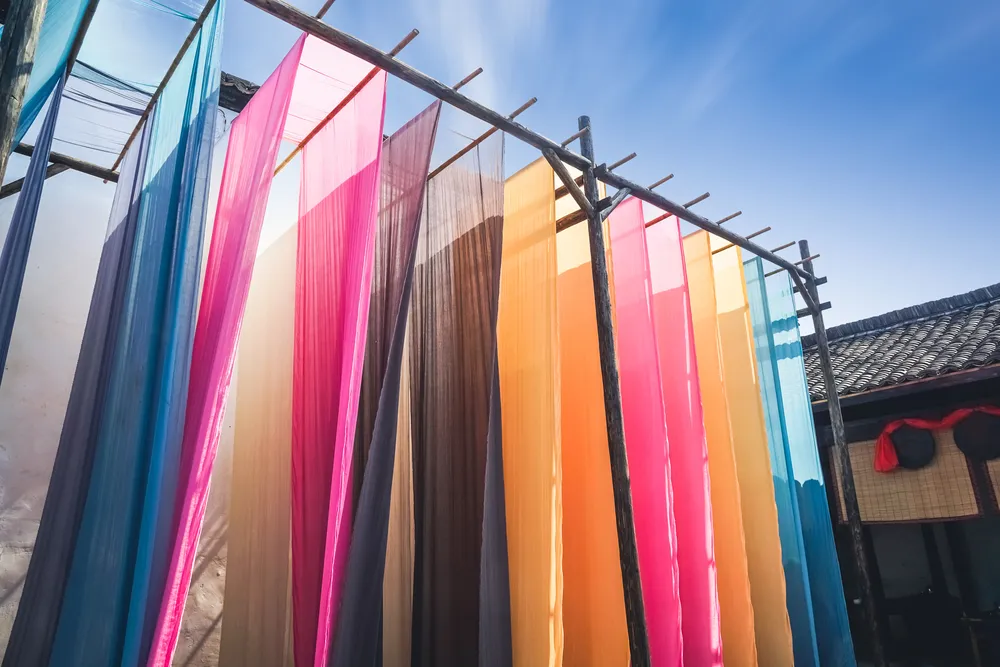
The Impact of Liquor Ratio Control on Dyeing Accuracy
Using the infrared sampler as an example, a 5g sample fabric weight is preferable during sampling, and the dye solution volume can be adjusted to 100 ml with water and acetic acid solution, resulting in a bath ratio of 1:20. In actual production, with a domestic high-temperature and high-pressure jet overflow J-type cylinder, the fabric weight is typically around 320 kg. In spring and summer, for thin fabric dyeing, a small-diameter nozzle can be used to maintain the circulation speed. With 4t of water in the dyeing cylinder, the bath ratio is approximately 1:12. In practice, the 1:20 bath ratio of the infrared sampler meets actual production requirements. If the sample fabric weight is 2g and the liquid level is too high during sampling, the bath ratio can reach 1:100.
When dyeing medium and light colors, a tenfold difference in bath ratio between the laboratory and production can lead to a darker actual production color. Correcting a too-dark fabric color through stripping can cause excessive damage to the fabric’s strength.
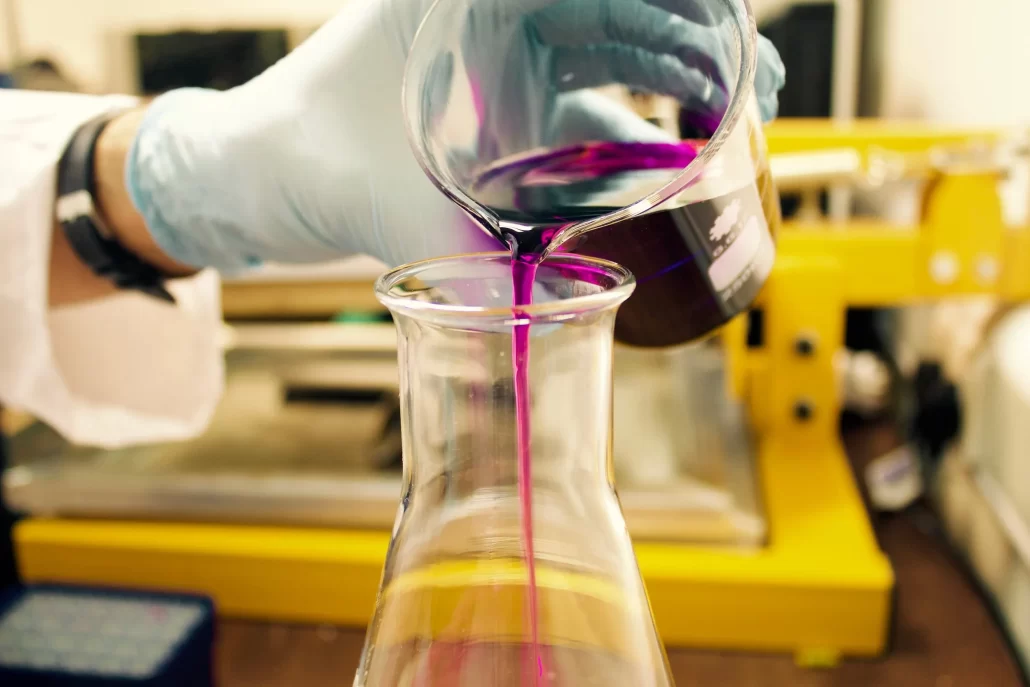
Fabric Weighing and Preparation in the Laboratory
Fabric Weighing
Even with an ordinary tray balance, accurate dye weighing for laboratory sampling is possible as long as the weights are precise. Wrap the dye with white paper when taking it. Ensure there are no water droplets on the balance trays with white paper. After adjusting the balance, weigh the dye. If the sampling fabric weighs 5g, weigh 5g of dye for easy formula conversion.
Use a 1000 ml volumetric flask to hold 1000 ml of distilled water, pour the weighed 5g dye slowly into the flask, and dissolve all the dye at the neck and bottom. Then transfer the prepared dye to a 1000 ml wide-mouth bottle for storage. Before using the dye from the wide-mouth bottle, invert and shake it well until all the bottom dye is dissolved. The wide-mouth bottle facilitates dye transfer.
Fabric Preparation
Before using a pipette to transfer the dye solution, ensure both the inside and outside of the pipette are dry and clean. Each dye bottle should have a dedicated pipette during sampling. Using a single pipette for multiple dyes, even with thorough rinsing, cannot guarantee its cleanliness. Some technicians habitually shake off water droplets from the pipette after cleaning before using it for another disperse dye. Over time, this can cause dye spots on the sampler’s workbench back wall. Residual dye and water droplets on the pipette can affect the purity and concentration stability of other dyes. Therefore, a dedicated pipette per bottle is essential for maintaining dye quality.
After sampling, clean all pipettes and place them in the oven for future use. Despite this, to ensure color accuracy, re-prepare the dye after using two-thirds of each bottle. An automatic dispensing system can further reduce color errors caused by liquid absorption during sampling. Combining it with an automatic color measurement and matching system can significantly improve the dyeing and printing factory’s color management. The magnetic stirrer in the automatic dispensing system reduces the effort required for dye preparation.
Accurate fabric weighing is crucial for textile dyeing processes. Using precision balances and volumetric flasks ensures consistency across fabric dyeing methods. Sample dyeing machines can provide optimal results when dye concentrations are controlled.

pH Value
The pH value for dyeing polyester with disperse dyes should be between 4 and 6. In a domestic high-temperature and high-pressure jet overflow J-type cylinder, adding 1000 ml of glacial acetic acid to 4t of water during dyeing can adjust the pH value within this range. For laboratory sampling, prepare acetic acid by dissolving 10 ml of glacial acetic acid in 1000 ml of water. During sampling, add 10 ml of the diluted acetic acid to the dye cup to maintain the pH value between 4 and 6.
Fabric
Fabric Weighing
Polyester fabric has a relatively low moisture regain, so when weighing samples, the influence of the dry fabric’s water content on color accuracy is minimal. In summer, turn off the electric fan when weighing the fabric. If possible, install air conditioning in the laboratory. The sample fabric weight should match the dye concentration.
Textile dyeing accuracy depends heavily on precise dye weighing. Standardized practices in dyeing labs involve:
- Accurate weighing of disperse dyes.
- Proper dissolution techniques for even distribution.
Fabric Acquisition
Ordinary polyester fabric for sampling can be cut by the laboratory technician from the white fabric warehouse. When cutting, note the fabric batch number and keep the fabric head straight for easy sewing during fabric preparation. Light-colored sampling fabrics can be pretreated in the laboratory by adding a little washing powder to hot water and using a washing machine. After washing, dry the fabric in a clean oven at a temperature not exceeding 100°C.
For polyester fabrics requiring alkali reduction, they must be reduced before sampling. The sample fabrics for reduction must also be pre-set. The hanging box of the intermittent alkali reduction equipment can be used by the reduction shift supervisor to control the fabric’s reduction hand feel and complete the reduction of the sampling fabric. The reduction shift supervisor is responsible for controlling the sample fabric’s hand feel.
Elastic fabric sampling fabrics can only be obtained after pre-setting. Pre-shrinking and pre-setting make the fiber’s internal orientation more uniform, affecting the fabric’s dyeing depth. After reduction, the fiber’s specific surface area increases, enhancing the dyeing depth. Pre-shrinking and pre-setting also improve the dimensional stability of elastic fabrics. Reduction fabrics require both pre-setting and alkali reduction. Therefore, using the sample fabric for sampling after pre-setting or reduction ensures color accuracy.
Common Fabric Dyeing Methods and Techniques
Various fabric dyeing methods can be employed for polyester dyeing:
Exhaust Dyeing: Ideal for batch processes.
Continuous Dyeing: Best for large-scale operations with continuous dyeing machines.
Lab Dyeing: Controlled testing using laboratory sample dyeing machines.
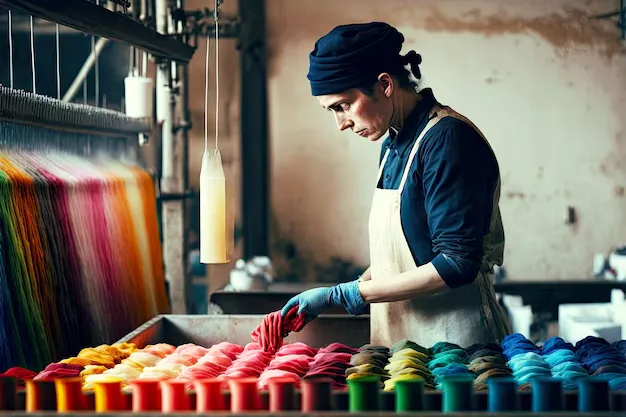
Color Management
Relying solely on comparing samples after dyeing in the large cylinder is insufficient for ensuring color accuracy. Most customer samples have undergone finished product setting. The thermal migration and sublimation of disperse dyes during the setting process further affect color accuracy. Each shift supervisor in the setting process shares the same responsibility as the dyeing shift supervisor in controlling color accuracy. In this regard, the production technical section chief has a greater responsibility than the dyeing workshop director and the setting workshop director.
The laboratory should have a customer color file administrator. The laboratory shift supervisor, the dyeing shift supervisor, and the finished product setting shift supervisor are responsible for providing the original materials for the customer color file to the administrator. A customer color file should be established to store customer samples, laboratory color samples, large samples from the dyeing cylinder, and color samples after setting. Accurate sample making is the foundation. Adjusting the dyeing formula and process based on the large cylinder production color and the setting process based on the post-setting color are essential for ensuring color accuracy.
Conclusion
A well-managed dyeing lab with precise textile dyeing processes ensures high accuracy in color matching for polyester fabrics. Implementing proper fabric dyeing methods and utilizing advanced sample dyeing machines, including IR lab dyeing machines and continuous dyeing machines, can significantly improve bulk production quality. By using high-quality laboratory dyeing equipment and adhering to best practices for dye weighing, solution preparation, and bath ratio control, textile manufacturers can significantly improve their color consistency from the laboratory to bulk production. Regular equipment maintenance and proper handling further ensure optimal dyeing results. Investing in reliable laboratory dyeing systems ultimately enhances production efficiency and product quality, making it a crucial step for textile factories. Maintaining consistency in lab dyeing practices leads to better reproducibility and superior fabric finishes.
For more valuable insights on textile testing, we encourage you to subscribe to our website or reach out to us using the following contact information:
Email: sales@chivention.com
WhatsApp: +86 180 2511 4082
Linkedin: Chiuvention
